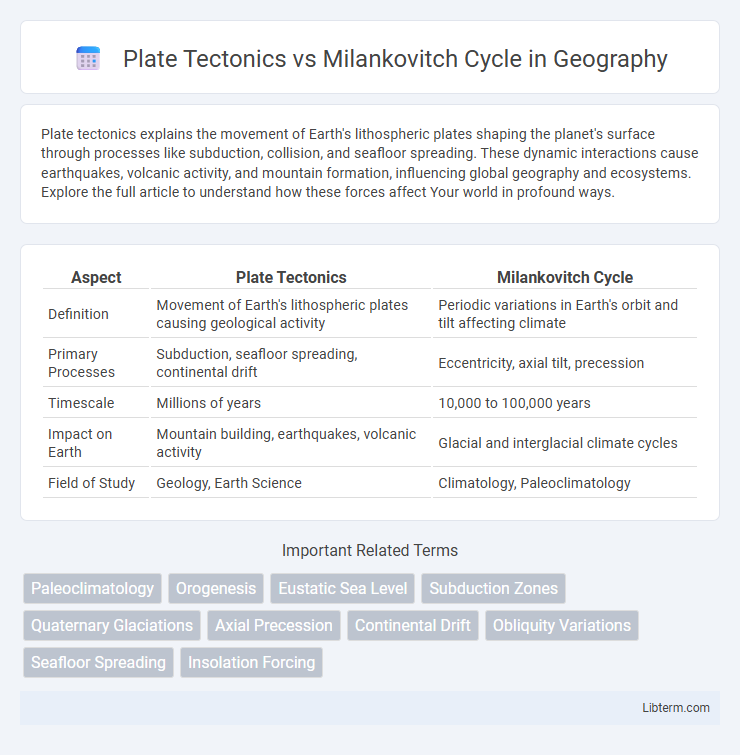Plate tectonics explains the movement of Earth's lithospheric plates shaping the planet's surface through processes like subduction, collision, and seafloor spreading. These dynamic interactions cause earthquakes, volcanic activity, and mountain formation, influencing global geography and ecosystems. Explore the full article to understand how these forces affect Your world in profound ways.
Table of Comparison
| Aspect | Plate Tectonics | Milankovitch Cycle |
|---|---|---|
| Definition | Movement of Earth's lithospheric plates causing geological activity | Periodic variations in Earth's orbit and tilt affecting climate |
| Primary Processes | Subduction, seafloor spreading, continental drift | Eccentricity, axial tilt, precession |
| Timescale | Millions of years | 10,000 to 100,000 years |
| Impact on Earth | Mountain building, earthquakes, volcanic activity | Glacial and interglacial climate cycles |
| Field of Study | Geology, Earth Science | Climatology, Paleoclimatology |
Introduction to Plate Tectonics and Milankovitch Cycle
Plate tectonics involves the movement of Earth's lithospheric plates, driving continental drift, earthquakes, and mountain formation through mechanisms like subduction and seafloor spreading. The Milankovitch Cycle describes variations in Earth's orbital parameters--eccentricity, axial tilt, and precession--that influence climatic patterns and glacial-interglacial cycles over tens to hundreds of thousands of years. Understanding both plate tectonics and Milankovitch cycles is crucial to comprehending Earth's geological and climatic history.
Fundamental Principles of Plate Tectonics
Plate tectonics is governed by the movement of Earth's lithospheric plates driven by mantle convection, slab pull, and ridge push mechanisms, reshaping continents and ocean basins over millions of years. This process explains phenomena such as earthquakes, volcanic activity, and mountain formation by the interaction of divergent, convergent, and transform plate boundaries. Unlike Milankovitch cycles, which influence Earth's climate through orbital variations, plate tectonics fundamentally alters Earth's surface and internal dynamics through geophysical forces.
Overview of the Milankovitch Cycle
The Milankovitch Cycle describes the collective effects of changes in Earth's movements on its climate over thousands of years, driven by variations in eccentricity, axial tilt, and precession. These orbital variations influence the distribution and intensity of solar radiation, playing a crucial role in triggering glacial and interglacial periods. Unlike plate tectonics, which involve slow movements of Earth's lithospheric plates affecting long-term geological features, the Milankovitch Cycle directly impacts periodic climate patterns.
Geological Impact of Plate Movements
Plate tectonics drives the formation and destruction of Earth's continents and ocean basins, significantly shaping the planet's geological features over millions of years. The movement of tectonic plates triggers volcanic activity, mountain building, and earthquake occurrences, continually remodeling the Earth's crust. These geological processes influence climate and sea level changes, distinguishing plate tectonics as a fundamental mechanism in Earth's long-term environmental evolution compared to the Milankovitch cycles' orbital variations.
Climate Influence of Orbital Variations
Milankovitch cycles describe long-term variations in Earth's orbit, tilt, and precession, driving changes in solar radiation and triggering glacial and interglacial periods. Plate tectonics influence climate through the reconfiguration of continents and ocean currents, impacting carbon cycling and atmospheric CO2 over millions of years. Orbital variations primarily affect climate on timescales of tens to hundreds of thousands of years, while plate tectonics shape climate over geological epochs spanning millions of years.
Timescales: Plate Tectonics vs Milankovitch Cycle
Plate tectonics operates on a timescale of millions to hundreds of millions of years, driving long-term continental drift, mountain building, and ocean basin formation. The Milankovitch cycles occur over tens to hundreds of thousands of years, influencing Earth's climate through periodic changes in orbital eccentricity, axial tilt, and precession. These differing timescales highlight how plate tectonics shapes geological features gradually, whereas Milankovitch cycles affect glacial and interglacial climate patterns on shorter geological intervals.
Plate Tectonics and Earth’s Long-Term Climate
Plate tectonics drives Earth's long-term climate by influencing atmospheric CO2 levels through volcanic activity and the subduction of carbon-bearing rocks, directly affecting global temperature over millions of years. The movement of continents alters ocean currents and albedo, shaping climate patterns and ice sheet dynamics. These geologic processes provide a slower, more sustained mechanism for climate change compared to the Milankovitch cycles, which operate on shorter, orbital timescales.
Milankovitch Cycles and Ice Age Triggers
Milankovitch Cycles describe variations in Earth's orbital eccentricity, axial tilt, and precession that influence solar radiation distribution, driving long-term climate patterns and Ice Age cycles. These astronomical factors alter the intensity and timing of seasons, leading to gradual cooling or warming trends that trigger glacial and interglacial periods. Plate tectonics contribute to climate shifts over millions of years, but Milankovitch Cycles are primary triggers for the pacing of Ice Ages during the Quaternary period.
Interactions Between Tectonics and Orbital Cycles
Interactions between plate tectonics and Milankovitch cycles influence long-term climate patterns by modulating Earth's orbital parameters and geological processes. Plate tectonics shapes ocean basins and continental configurations, which affect Earth's albedo and carbon cycle, thereby amplifying or dampening the climatic effects driven by Milankovitch orbital variations. This dynamic interplay governs glacial-interglacial cycles through feedback mechanisms involving volcanic activity, sedimentation, and changes in atmospheric greenhouse gas concentrations.
Comparative Analysis: Earth System Impacts
Plate tectonics drives long-term changes in Earth's climate by altering ocean circulation, atmospheric CO2 levels through volcanic activity, and the distribution of continents, leading to gradual shifts in climate over millions of years. In contrast, the Milankovitch Cycle influences shorter-term climate variations caused by periodic changes in Earth's orbital parameters--eccentricity, axial tilt, and precession--impacting solar radiation distribution and triggering glacial and interglacial cycles over tens to hundreds of thousands of years. While plate tectonics gradually shapes Earth's surface and atmospheric composition, Milankovitch cycles modulate climate through cyclical solar insolation changes, together controlling Earth's climate system at different temporal scales.
Plate Tectonics Infographic

 libterm.com
libterm.com